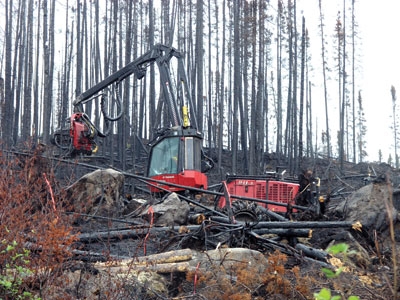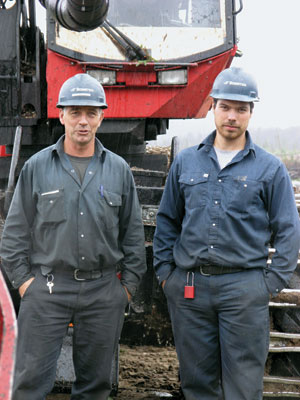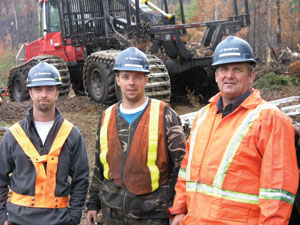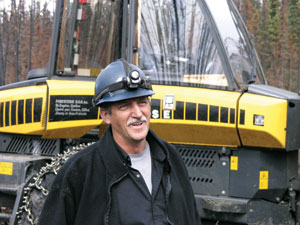
New Gear
Harvesting
New Gear
Fuel for Thought
Environmental objectives are good, but when they dovetail with powerful economic drivers you’ve really got a potent cocktail. That’s the concoction the folks at Bowater’s northern Quebec operations are downing these days, as demands to reduce forest machine fuel consumption under their CSA-Z809 certification scheme combine with stubbornly high diesel prices to create what at the outset looks like a win-win-win scenario.
November 22, 2011 By Scott Jamieson
 Environmental objectives are good
Environmental objectives are goodBowater wins, because reduced fuel consumption per cubic metre looks good to its greener customers, and also allows it to control the fuel subsidies it pays loggers. Contractors win because if they reduce fuel consumption while maintaining production, they pocket the difference, plus a littler extra early-adopter bonus. Finally, we all win, as do our children, since less fuel and green house gas emissions are required to make that same 2×6. It all makes wood products an even greener option.
Subsidy for Nothing?
Environmental issues aside, Bowater’s objective with the new fuel saving regime is simple – cost control in an era of stalled commodity pricing and rising costs. In the short term, companies can pay fuel surcharges to loggers, but with crude over $80/barrel and set to stay there, longer-term solutions are required.
In an effort to gain some control over the carbon cost of delivered wood, Bowater in northern Quebec has created a fuel conservation incentive program that is both simple and effective. In theoretical terms, if a contractor cuts 1,000 m3/wk with a two-machine CTL team, that volume is multiplied by a base consumption target of 2.5 l/m. He then receives a fuel adjustment on 2,500 litres, depending on the price of diesel. If his consumption is actually down at 2.0 l/m3, and thus he consumed just 2,000 litres, he’ll get the adjustment on 500 extra litres he did not in fact use as an incentive for early adopters.
Just for discussion, let’s assume diesel at 86 cents/litre and a fuel adjustment of around 30 cents/litre. Our theoretical example above nets the logger an extra $150, plus some $430 worth of diesel he didn’t have to buy, for an extra $580 in his pocket Friday afternoon. It’s not bad, but the other element is still production. Get stuck in small wood, bad ground, or heavy undergrowth, or lose 10 hours on a breakdown, and the wood volume side of the equation goes to hell. Thus a fuel thirsty, but productive full-tree system in good wood can still feasibly make the 2.5 l/m3 target, while an inexperienced CTL crew in bad wood can fall short. True, but at least the simple incentive program is a starting point.
Indeed it is, and it is just a start. The 2.5 l/m3 threshold is likely a moving target, as machine efficiency and operator skills improve. For example, a recent study by Torbjorn Brunberg of Sweden’s version of FERIC, Skogforsk, found CTL crews there averaged just 1.7 l/m3. Plantation wood quality is no doubt far higher, but it shows the potential for further fuel reductions that companies like Bowater are looking for.
For now, the strategy of a large number of local contractors has been to switch from large tracked harvesters to smaller, more efficient rubber-tire machines. All four contractors we met had taken that approach, making the switch from over seven years ago to just this past spring. All reported the machines were up to the job, and using much less fuel.
Rolling along
The key of this new reduced-fuel reality is the ability of rubber tire harvesters to do the same job as their tracked predecessors, but with significantly less thirst. The second part’s no big issue. Purpose-built track machines are more efficient each year, as more sophisticated engines and controls are employed. Still, they’ve a way to go to catch purpose-built rubber tire harvesters, themselves a moving target. Comparisons vary from machine to machine, but a safe range for most rubber tire harvesters is 16 to 22 l/hr, while fuel consumption for track harvesters starts at around 25 l/hr and can top 35 in some of the larger machines.
Sipping less is easy; producing the same depends on a number of variables, which when listed in order of importance for most parts of Canada includes company planning, operator skill, contractor attitude, dealer support, tree size, species mix, unmerchantables, and terrain. In this sense, this particular part of Quebec is as well set up for rubber tire harvesters as any.
For starters, CTL harvesting is already well established, representing over 85% of the machinery in the Lac St. Jean region, supported by a solid base of skilled operators, seasoned contractors, and experienced dealers. That’s a good thing, as rough numbers from FERIC peg full-tree systems in the 3.0 to 4.8 l/m3 range, with CTL systems (tracked and rubber tire combined) at 1.6 to 2.7 l/m3. That’s a gap of some 1.4 to 2.6 l/m3, with the high range likely being rubber tire systems.
Back in Lac St. Jean, contractor and operator attitudes regarding rubber tire machines may vary, but tree size and species mix is near perfect. It’s almost all softwood in the 7 to 12 tree/m3 range. Terrain can range from flat and easy (rare) to nasty, broken, hilly, and rocky (more common), and snow depth – well this is northern Quebec, after all – but 6WD and 8WD forwarders have been making their way through it for decades now. In short – rubber tire machines can produce here.
In fact, several of the rubber-tire converts we spoke to said that if anything, their new machines were more productive. In at least one case this could be the result of the new machine having much higher uptime, but faster booms, better visibility, reduced fatigue, and better controls-hydraulics were all mentioned as well. “These machines are more sophisticated, so we don’t have to be,” was how one seasoned CTL logger put it. Fair enough.
But just what does productive mean in these parts? Despite marginal wood, loggers here are expected to produce to survive, and for the most part they do a remarkable job. There are legendary producers in this part of the world, but getting back to averages, most loggers seem to target 1,500 m3/wk with a two-machine CTL crew, with close to 100 scheduled production hours. That’s the target, and wood quality and terrain can often conspire to spoil things. Still, contractors we interviewed ranged from just over 1,200 to 1,600 m3/wk as fairly standard. One recent rubber tire convert said his 2007 production with two machines would hit 50,000 m3, despite a dismal 31 operating weeks.
Of course the other side of the coin is cost. The same contractor told CFI that “if I hit 50,000 m3, and keep a strict eye on my costs, I’ll still do alright – No complaints. But if I let the costs get away from me even a bit, all bets are off.”
This is where the real incentive for reducing fuel consumption comes in. The extra subsidy is welcome. Heck, I’d like to be paid for fuel I don’t use. The real money, however, is in not spending those 86 cents a litre in the first place. See the contractor box below for details, but suffice it to say that a double-shifting CTL contractor can save as much as $1,000 per week for each harvester he runs, plus the subsidy top up. In many cases today, that may make the difference between profit and loss, or can easily double a logger’s margin.
Now multiply 0.5 litres per m3 times all the wood harvested per province per year, and shout the greenhouse benefits loud and clear. That’s some 40 million litres in BC and about 20 million in Quebec alone. Like the title says – It’s fuel for thought.
Controlling the Thirst
Theoretical fuel savings and productivity calculations are fine, but give me the real deal any day. How much fuel did you burn to produce the same amount of wood with the same operators in similar wood before, and how much now? That’s what I want to know, and most readers will agree. So that’s what I set out to find out when I jumped in Daniel Lahaie’s Dodge Durango this past summer, and headed out for a little drive. Daniel is a veteran iron peddler with Komatsu Forest, and his history dates back to his role as marketing manager with Harricana, back when high-speed felling heads were first introduced and computers had punch cards. When you go for a little drive with Daniel, you’d best be set for 2,000 km or more, much of it on logging roads.
After a little drive from Montreal to Dolbeau (650 km), Daniel and I met up with Nicol Dallaire, another veteran equipment salesman with Federal Equipment. After 200 km of bush road, we meet our first logger, and so the day went. Both Daniel and Nicol have spent much time and effort working with Bowater’s contractors to help them gain full advantage of the new fuel reality, and they are excited about the prospects of lower-cost logging in the right conditions.
Just one caveat – Comparing loggers and production numbers is meaningful only to a point – These loggers were all from the same general region of Quebec, but were at times 100 km apart, and worked in vastly different wood and terrain, with different experience levels using purpose-built CTL wheel harvesters. Differences in production numbers reflect that more than anything else.
Finally thanks to Daniel and Nicol for playing host and chauffeur, again, for making long miles pass quickly, and for pretending to understand all of my French. Here’s a snippet of what we found out that day.
Contractor: Dominic & Pierre Labrecque
Rather than invest some $45,000 in repairs this past March, Dominic and his nephew/partner switched from an older Valmet track carrier to this new Valmet 911.3 6WD harvester, and have not looked back. Uptime has been superb with the new machine, hourly production is where it needs to be, and he is on target to make 50,000 m3 with the 911.3 and his Valmet 890.2 8WD forwarder despite only getting 30 to 31 weeks running time in the down market. Obviously, the learning curve was not too tough, even while working a large burn salvage in broken terrain.

Fuel Savings: No hesitation when asked, as Dominic’s been tracking it, and his wallet, closely. “We’re using 1,000 litres per week less (90-100 scheduled hours), so that’s over $800 per week.” That’s not counting the extra incentive, which based on his weekly production (1,500 m3) and fuel consumption (1.85 l/m3) likely amounts to another $300/wk in incentives for fuel not burned (not actual numbers – all CFI estimates only).
Comment: “We bought the 911 to get away from some annual maintenance issues, and so far it has proven as productive, or more than the old machine. There’s a learning curve to get used to the mobility and crane. It’s more complex, but less complicated to run is how we see it. The fuel savings are a nice extra,” he says with a quick smile.
Contractor: Adrien Sirois
Adrien and his son Steeve have been on the cover of CFI before, when the innovative duo got their Valmet 921 harvester some seven years back. With 26,000 hours, it’s still “a heck-uv-a machine” Adrien says. It looks new to boot. New to the team is a shiny Valmet 890.3 18-tonne forwarder the loggers say is a good match to their 921. Both get impressive mileage given the up-and-down terrain and pace, with the beefy 921 averaging 20 l/hr. As for the 890.3, Adrien says it uses similar fuel to his older 860.1, despite carrying a whole lot more wood. When 890.3 operator Hugues Gaudreault sees the doubt in my eyes, he promises to send me actual fuel reports at the end of his week. Sure enough, fuel consumption for the past 10 weeks has averaged 12.13 l/hr. Calculate that across the massive payload, and you gotta love big forwarders.

Fuel Savings: Hard to compare, as Adrien and team have been on wheels for seven years. Still at 32 to 33 l/hr for both, he’s 5 to 10 l/hr below other track harvester-large forwarder combos we saw, so let’s say a fair annual number could start at $15,000 in fuel savings, and move up from there in a hurry.
Comment: “It’s hard to compare production here, as it all depends on terrain and wood size – Steep and small respectively here. We’ve always done well on the operating costs side, and on uptime, but it’s hard to make the production to reach the fuel incentive target. The volume’s just not there.”
Contractor: Gilles Dufour &Gaston Rousseau (DDR)
The duo have all wheels, with a Timberpro 830 combi machine with Ponsse H70 head that runs almost full time as a forwarder behind a spanking new Ponsse Ergo rubber tire harvester that replaced a large track harvester. The forwarder runs 18 to 19 l/hr according to the operator, but climbs to 23 or so as harvester according to Gilles. An avid CFI reader despite living in an entirely French community, Gilles says moving to the Ergo has made a huge difference in his fuel bill. Still, a number of factors conspire to keep his production too low to meet the volume-based incentive.

Fuel Savings: “I’m saving 1,100 litres per week over the track machine – no doubt. It’s about 18 to 20 l/hr, and is as productive in this wood.” That’s some $950 per week, or $30,000 to $40,000 per year depending on the schedule.
Comment: “You really have to watch your costs in this business now, as the margin is just not there otherwise. This (the Ergo) is part of that – I just hope it will be enough.”
Print this page